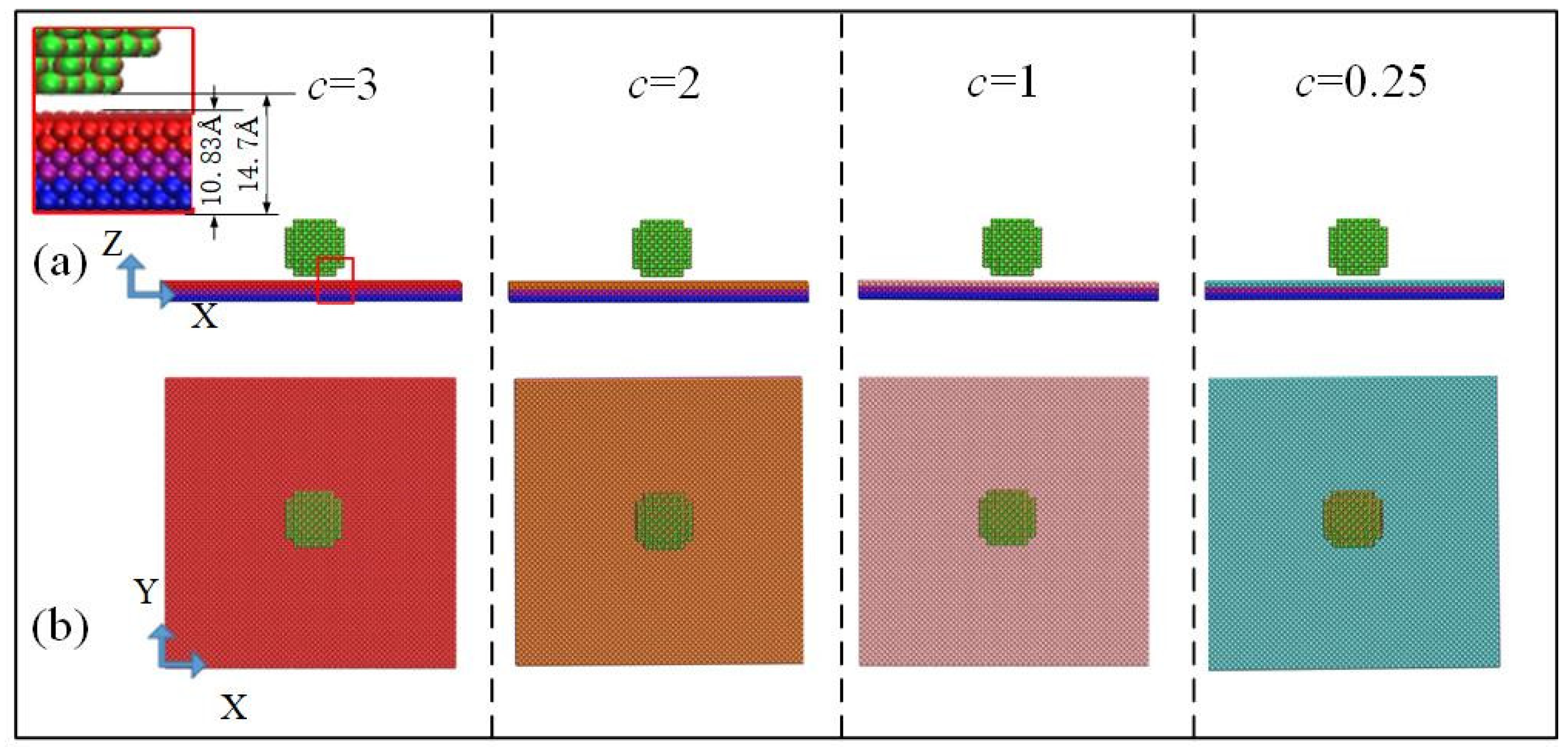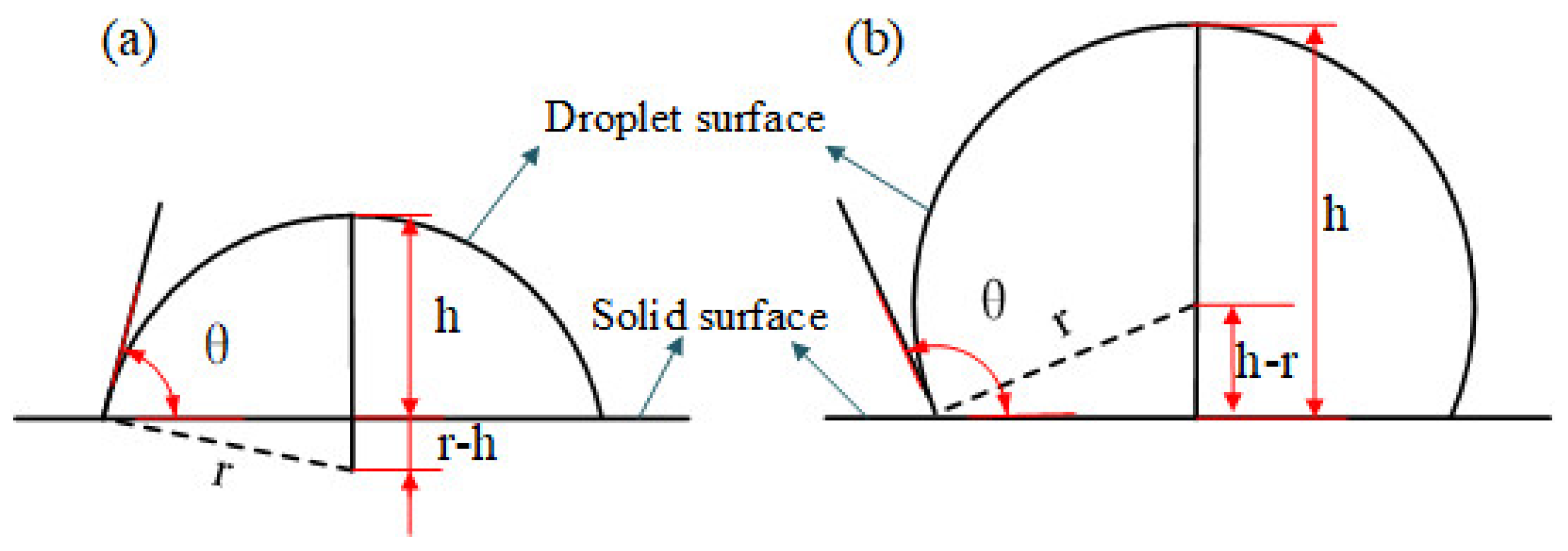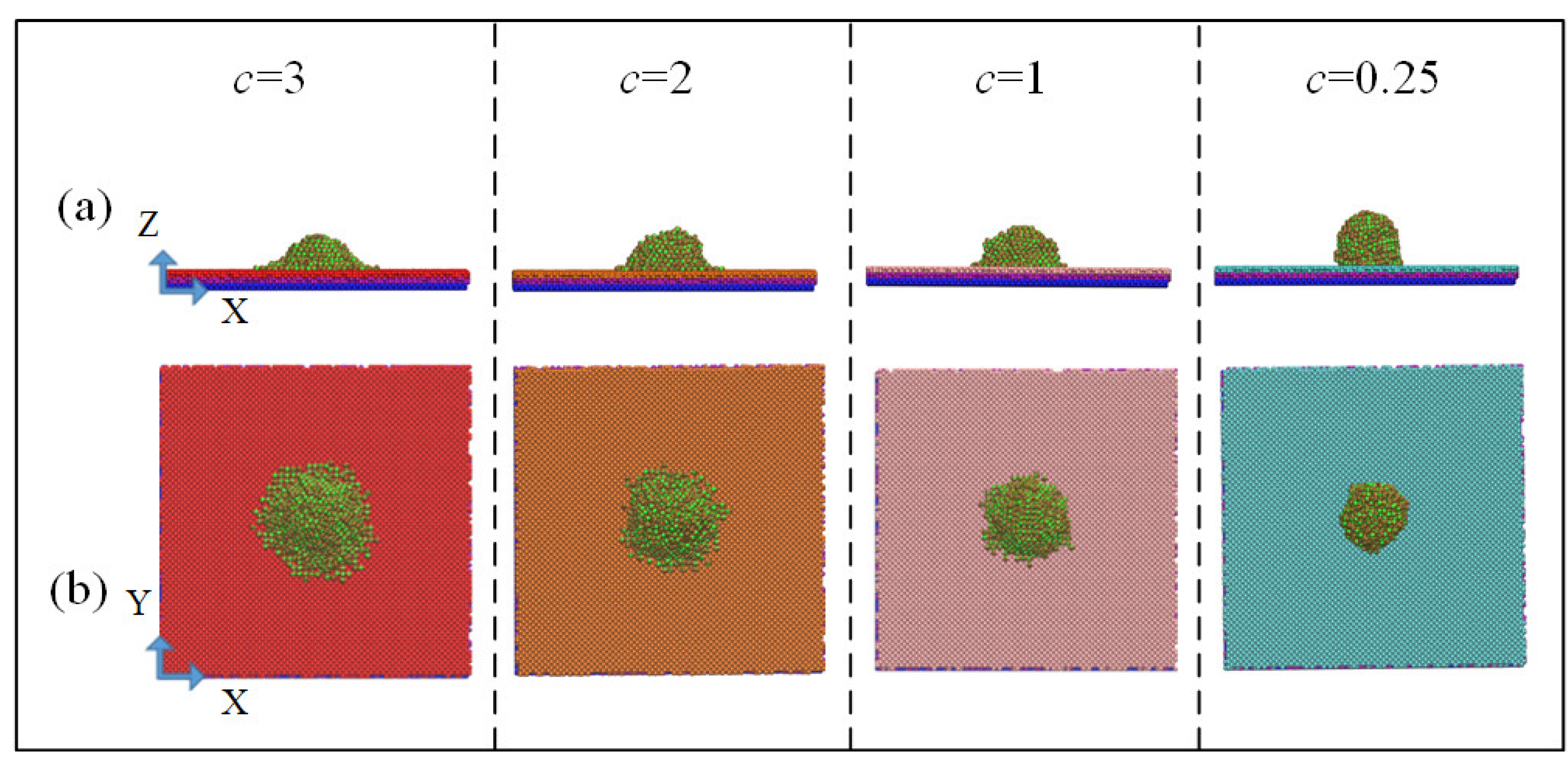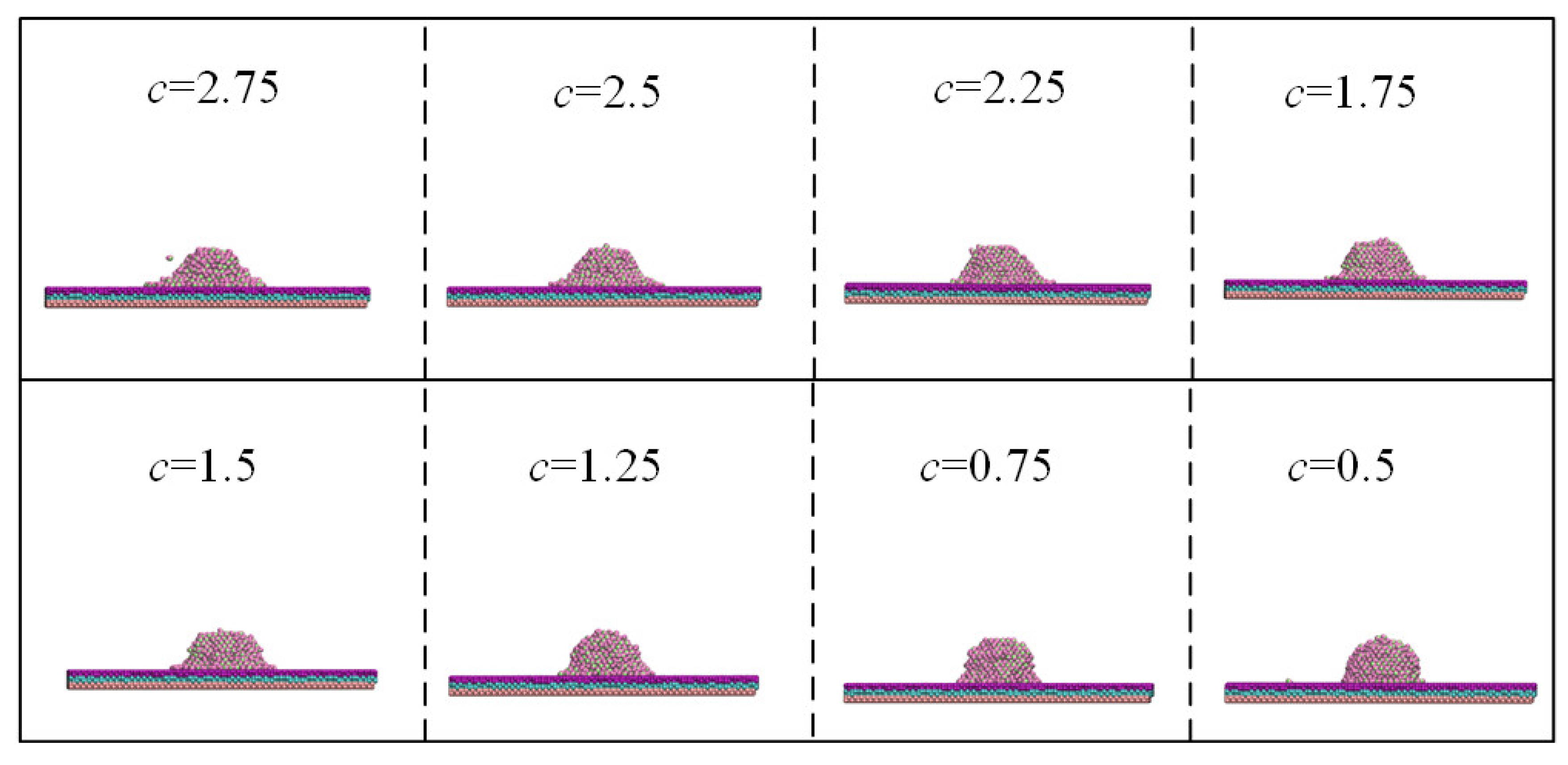Influence of Tuning Potential Parameters on Wettability of Smooth Copper Plate: A Molecular Dynamic Study
Abstract
:1. Introduction
2. Simulation Models and Methods
3. Results and Discussion
3.1. The Wettability and Spreading Behavior of Droplets
3.2. Contact Angle Measurements and Analysis
3.3. The Influence of Tuning Potential Parameters on Potential Energy and Spreading Behavior of Water Droplets
4. Conclusions
Author Contributions
Funding
Institutional Review Board Statement
Informed Consent Statement
Data Availability Statement
Conflicts of Interest
References
- Bharat, B.; Chae, J.Y. Wetting, adhesion and friction of superhydrophobic and hydrophilic leaves and fabricated micro/nanopatterned surfaces. J. Phys. Condens. Matter 2008, 20, 225010. [Google Scholar]
- Wenzel, R.N. Resistance of solid surfaces to wetting by water. Ind. Eng. Chem. 1936, 28, 988–994. [Google Scholar] [CrossRef]
- Jiang, L.; Wang, R.; Yang, B.; Li, T.J.; Tryk, D.A.; Fujishima, A.; Hashimoto, K.; Zhu, D.B. Binary cooperative complementary nanoscale interfacial materials. Pure Appl. Chem. 2000, 72, 73–81. [Google Scholar] [CrossRef]
- Nini, W.; Liangcai, Z.; Ting, F.; Zhaohui, W.; Xiaolei, D. Mechanism of heat transfer enhancement by nanochannels copper plate interface wettability: A molecular dynamics study. Int. J. Therm. Sci. 2021, 159, 106589. [Google Scholar]
- Feldbauer, G.; Wolloch, M.; Bedolla, P.O.; Mohn, P.; Redinger, J.; Vernes, A. Adhesion and material transfer between contacting Al and TiN surfaces from first principles. Phys. Rev. B 2015, 91, 165413. [Google Scholar] [CrossRef] [Green Version]
- Ge, P.; Wang, S.; Zhang, J.; Yang, B. Micro-/nanostructures meet anisotropic wetting: From preparation methods to applications. Mater. Horiz. 2020, 7, 2566–2595. [Google Scholar] [CrossRef]
- Bourdon, B.; Bertrand, E.; Di Marco, P.; Marengo, M.; Rioboo, R.; De Coninck, J. Wettability influence on the onset temperature of pool boiling: Experimental evidence onto ultra-smooth surfaces. Adv. Colloid Interface Sci. 2015, 221, 34–40. [Google Scholar] [CrossRef]
- Liu, Y.; Andrew, M.; Li, J.; Yeomans, J.M.; Wang, Z. Symmetry breaking in drop bouncing on curved surfaces. Nat. Commun. 2015, 6, 10034. [Google Scholar] [CrossRef] [Green Version]
- Chen, Y.; Zou, Y.; Wang, Y.; Han, D.; Yu, B. Bubble nucleation on various surfaces with inhomogeneous interface wettability based on molecular dynamics simulation. Int. Commun. Heat Mass Transf. 2018, 98, 135–142. [Google Scholar] [CrossRef]
- Misyura, S. Contact angle and droplet evaporation on the smooth and structured wall surface in a wide range of droplet diameters. Appl. Therm. Eng. 2017, 113, 472–480. [Google Scholar] [CrossRef]
- Al-Sharafi, A.; Yilbas, B.S.; Ali, H. Droplet heat transfer on micro-post arrays: Effect of droplet size on droplet thermal characteristics. Int. J. Heat Fluid Flow 2017, 68, 62–78. [Google Scholar] [CrossRef]
- Wen, R.; Lan, Z.; Peng, B.; Xu, W.; Yang, R.; Ma, X. Wetting Transition of Condensed Droplets on Nanostructured Superhydrophobic Surfaces: Coordination of Surface Properties and Condensing Conditions. ACS Appl. Mater. Interfaces 2017, 9, 13770–13777. [Google Scholar] [CrossRef]
- Kim, S.; Polycarpou, A.A.; Liang, H. Electrical-potential induced surface wettability of porous metallic nanostructures. Appl. Surf. Sci. 2015, 351, 460–465. [Google Scholar] [CrossRef]
- Niu, D.; Tang, G. Static and dynamic behavior of water droplet on solid surfaces with pillar-type nanostructures from molecular dynamics simulation. Int. J. Heat Mass Transf. 2014, 79, 647–654. [Google Scholar] [CrossRef]
- Hong, S.-D.; Ha, M.-Y. A Molecular Dynamics Simulation for the Moving Water Droplet on Atomistically Smooth Solid Surface. Trans. Korean Soc. Mech. Eng. B 2009, 33, 559–564. [Google Scholar] [CrossRef]
- Mao, Y.; Chen, C.-L.; Zhang, Y. Molecular dynamic study on contact angle of water droplet on a single-wall carbon nanotube (SWCNT) plate. Appl. Phys. A 2013, 111, 747–754. [Google Scholar] [CrossRef]
- Hong, S.D.; Ha, M.Y.; Balachandar, S. Static and dynamic contact angles of water droplet on a solid surface using molecular dynamics simulation. J. Colloid Interface Sci. 2009, 339, 187–195. [Google Scholar] [CrossRef]
- Xu, K.; Zhang, J.; Hao, X.; Zhang, C.; Wei, N.; Zhang, C. Wetting Properties of Defective Graphene Oxide: A Molecular Simulation Study. Molecules 2018, 23, 1439. [Google Scholar] [CrossRef] [Green Version]
- Chen, L.; Wang, S.-Y.; Xiang, X.; Tao, W.-Q. Mechanism of surface nanostructure changing wettability: A molecular dynamics simulation. Comput. Mater. Sci. 2020, 171, 109223. [Google Scholar] [CrossRef]
- Barisik, M.; Beskok, A. Wetting characterisation of silicon (1,0,0) surface. Mol. Simul. 2013, 39, 700–709. [Google Scholar] [CrossRef]
- Mao, Y.; Zhang, Y. Molecular dynamics simulation on rapid boiling of water on a hot copper plate. Appl. Therm. Eng. 2014, 62, 607–612. [Google Scholar] [CrossRef]
- Yi, P.; Poulikakos, D.; Walther, J.; Yadigaroglu, G. Molecular dynamics simulation of vaporization of an ultra-thin liquid argon layer on a surface. Int. J. Heat Mass Transf. 2002, 45, 2087–2100. [Google Scholar] [CrossRef]
- Davidchack, R.L.; Handel, R.; Tretyakov, M.V. Langevin thermostat for rigid body dynamics. J. Chem. Phys. 2009, 130, 234101. [Google Scholar] [CrossRef] [PubMed]
- Humphrey, W.; Dalke, A.; Schulten, K. VMD: Visual molecular dynamics. J. Mol. Graph. 1996, 14, 33–38. [Google Scholar] [CrossRef] [PubMed]
- Isaiev, M.; Burian, S.; Bulavin, L.; Gradeck, M.; Lemoine, F.; Termentzidis, K. Efficient tuning of potential parameters for liquid–solid interactions. Mol. Simul. 2015, 42, 910–915. [Google Scholar] [CrossRef]
- Diaz, R.; Guo, Z. Molecular dynamics study of wettability and pitch effects on maximum critical heat flux in evaporation and pool boiling heat transfer. Numer. Heat Transf. Part A Appl. 2017, 72, 891–903. [Google Scholar] [CrossRef]
- Fu, T.; Mao, Y.; Tang, Y.; Zhang, Y.; Yuan, W. Molecular Dynamics Simulation on Rapid Boiling of Thin Water Films on Cone-Shaped Nanostructure Surfaces. Nanoscale Microscale Thermophys. Eng. 2015, 19, 17–30. [Google Scholar] [CrossRef]
- Ryckaert, J.P.; Ciccotti, G.; Berendsen, H.J. Numerical Integration of the Cartesian Equations of Motion of a System with Constraints: Molecular Dynamics of n-Alkanes. J. Comput. Phys. 1977, 23, 327–341. [Google Scholar] [CrossRef] [Green Version]
- Fu, T.; Wu, N.; Lu, C.; Wang, J.; Wang, Q. Effect of nanostructure on wettability on copper surface: A molecular dynamic study. Mol. Simul. 2018, 45, 35–39. [Google Scholar] [CrossRef]
- Kim, S.J.; Bang, I.C.; Buongiorno, J. Surface wettability change during pool boiling of nanofluids and its effect on critical heat flux. Int. J. Heat Mass Transf. 2007, 50, 4105–4116. [Google Scholar] [CrossRef]
- Ding, W.; Krepper, E.; Hampel, U. Quantitative prediction of critical heat flux initiation in pool and flow boiling. Int. J. Therm. Sci. 2018, 125, 121–131. [Google Scholar] [CrossRef]
- Allred, T.P.; Weibel, J.A.; Garimella, S.V. Enabling Highly Effective Boiling from Superhydrophobic Surfaces. Phys. Rev. Lett. 2018, 120, 174501. [Google Scholar] [CrossRef] [PubMed] [Green Version]
- Bourdon, B.; Rioboo, R.; Marengo, M. Influence of the Wettability on the Boiling Onset. Langmuir 2012, 28, 1618. [Google Scholar] [CrossRef] [PubMed]








| Parameters | Values | Units |
|---|---|---|
| 0.006998 | eV | |
| 3.16438 | Å | |
| −1.04 | e | |
| 0.52 | e | |
| 0.06387 | eV | |
| 2.7172 | Å | |
| E | 274–306 | GPa |
| d | 3.615 | Å |
Disclaimer/Publisher’s Note: The statements, opinions and data contained in all publications are solely those of the individual author(s) and contributor(s) and not of MDPI and/or the editor(s). MDPI and/or the editor(s) disclaim responsibility for any injury to people or property resulting from any ideas, methods, instructions or products referred to in the content. |
© 2023 by the authors. Licensee MDPI, Basel, Switzerland. This article is an open access article distributed under the terms and conditions of the Creative Commons Attribution (CC BY) license (https://creativecommons.org/licenses/by/4.0/).
Share and Cite
Wu, N.; Zeng, L.; Chen, J.; Fu, T.; Zhang, F.; Zeng, Y. Influence of Tuning Potential Parameters on Wettability of Smooth Copper Plate: A Molecular Dynamic Study. Coatings 2023, 13, 1371. https://doi.org/10.3390/coatings13081371
Wu N, Zeng L, Chen J, Fu T, Zhang F, Zeng Y. Influence of Tuning Potential Parameters on Wettability of Smooth Copper Plate: A Molecular Dynamic Study. Coatings. 2023; 13(8):1371. https://doi.org/10.3390/coatings13081371
Chicago/Turabian StyleWu, Nini, Liangcai Zeng, Juan Chen, Ting Fu, Feng Zhang, and Yun Zeng. 2023. "Influence of Tuning Potential Parameters on Wettability of Smooth Copper Plate: A Molecular Dynamic Study" Coatings 13, no. 8: 1371. https://doi.org/10.3390/coatings13081371





